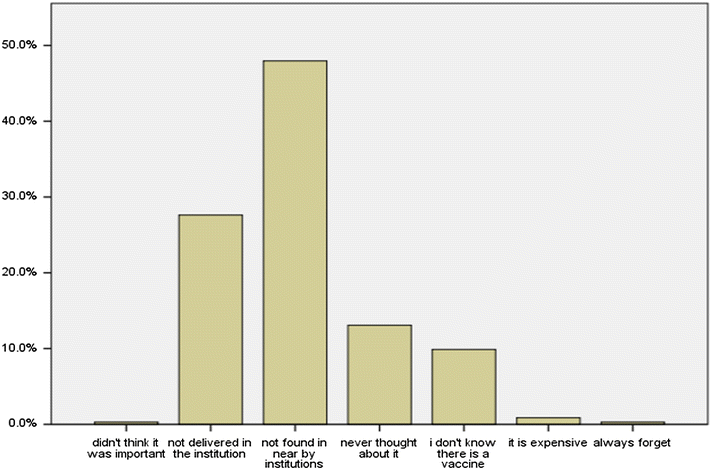Hepatitis B virus vaccination status and associated factors among health care workers in Shashemene Zonal Town, Shashemene, Ethiopia: a cross sectional study
- PMID: 28683822
- PMCID: PMC5501475
- DOI: 10.1186/s13104-017-2582-0
Hepatitis B virus vaccination status and associated factors among health care workers in Shashemene Zonal Town, Shashemene, Ethiopia: a cross sectional study
Abstract
Background: Hepatitis B virus (HBV) remains a major global health problem. More than three-quarters of HBV infection occur in Asia, the Middle East and Africa. Healthcare workers (HCWs) are at risk of acquiring HBV, hepatitis C (HCV) and human immunodeficiency virus (HIV) infections via exposure to patients' blood and bodily fluids. HBV infection is a recognized occupational hazard, and non-immune health professionals are at risk of acquiring the infection from their work. This study was intended to assess the level of HBV vaccination status and factors affecting the vaccination status of health care workers in Shashemene Zonal Town.
Methods: Institution based cross-sectional study was conducted and a simple random sampling technique was used to select study subjects. A total of 423 HCWs were enrolled in the study. A structured and pre-tested questionnaire was used to collect the required information through a face to face interview. Finally, data were processed and analyzed using Epi info version 7 and SPSS version 21. Both bivariate and multivariable logistic regression analyses were used to assess the effect of the various factors on vaccination status of HCWs. p value ≤0.05 at 95% CI was considered statistically significant.
Results: Overall, 53 (12.9%) respondents were found to be fully vaccinated. The multivariable logistic regression showed that, those respondents who are female, had ≥10 years of work experience and those working at governmental health care institutions were significantly associated with vaccination status (AOR = 3.84, 12.51, 2.45 respectively).
Conclusion: Our study revealed that vaccination status of subjects was below the WHO's estimation of vaccination rate among HCWs in developing countries and was very poor when compared with other countries. This is a serious public health problem and challenge for a country with high prevalence of hepatitis B infection.
Figures
Similar articles
-
Prevalence of hepatitis B virus infection among health care workers in a tertiary hospital in Tanzania.BMC Infect Dis. 2015 Sep 23;15:386. doi: 10.1186/s12879-015-1129-z. BMC Infect Dis. 2015. PMID: 26399765 Free PMC article.
-
Hepatitis B vaccine knowledge and vaccination status among health care workers of Bahir Dar City Administration, Northwest Ethiopia: a cross sectional study.BMC Infect Dis. 2015 Jan 31;15:30. doi: 10.1186/s12879-015-0756-8. BMC Infect Dis. 2015. PMID: 25637342 Free PMC article.
-
Knowledge of hepatitis B infection, hepatitis B vaccine, and vaccination status with its associated factors among healthcare workers in Kampot and Kep Provinces, Cambodia.BMC Infect Dis. 2024 Jul 1;24(1):658. doi: 10.1186/s12879-024-09571-y. BMC Infect Dis. 2024. PMID: 38956495 Free PMC article.
-
Seroprevalence of viral hepatitis B and C infections among healthcare workers in Ethiopia: A systematic review and meta-analysis.PLoS One. 2024 Nov 7;19(11):e0312959. doi: 10.1371/journal.pone.0312959. eCollection 2024. PLoS One. 2024. PMID: 39509362 Free PMC article.
-
Full-dose hepatitis B virus vaccination coverage and associated factors among health care workers in Ethiopia: A systematic review and meta-analysis.PLoS One. 2020 Oct 27;15(10):e0241226. doi: 10.1371/journal.pone.0241226. eCollection 2020. PLoS One. 2020. PMID: 33108365 Free PMC article.
Cited by
-
Hepatitis B and C virus infection among healthcare workers in Africa: a systematic review and meta-analysis.Environ Health Prev Med. 2021 Jun 2;26(1):61. doi: 10.1186/s12199-021-00983-9. Environ Health Prev Med. 2021. PMID: 34078258 Free PMC article.
-
Hepatitis B Vaccination Uptake Rate and Predictors in Healthcare Professionals of Ethiopia.Risk Manag Healthc Policy. 2020 Dec 8;13:2875-2885. doi: 10.2147/RMHP.S286488. eCollection 2020. Risk Manag Healthc Policy. 2020. PMID: 33335433 Free PMC article.
-
Magnitude of Needlestick and Sharp Injury and Its Associated Factors Among Nurses Working at Health Institutions in Western Ethiopia, 2020.Risk Manag Healthc Policy. 2020 Sep 15;13:1589-1602. doi: 10.2147/RMHP.S254641. eCollection 2020. Risk Manag Healthc Policy. 2020. PMID: 32982517 Free PMC article.
-
Hepatitis B vaccine uptake among healthcare workers in a referral hospital, Accra.Pan Afr Med J. 2019 Jun 10;33:96. doi: 10.11604/pamj.2019.33.96.18042. eCollection 2019. Pan Afr Med J. 2019. PMID: 31489074 Free PMC article.
-
Attitude and Vaccination Status of Healthcare Workers against Hepatitis B Infection in a Teaching Hospital, Ethiopia.Scientifica (Cairo). 2018 Apr 2;2018:6705305. doi: 10.1155/2018/6705305. eCollection 2018. Scientifica (Cairo). 2018. PMID: 29808158 Free PMC article.
References
-
- Elin D, Ellinor F. Knowledge about hepatitis B virus infection and attitudes towards hepatitis B virus vaccination among Vietnamese university students in Ho chi minh city. A thesis submitted to Uppsala university department of public health and caring Sciences. 2013.
-
- Samir M, Abubakir M, Nazar P. Knowledge about hepatitis infection among medical students in Ebril city, Iraq. Eur Sci J. 2013;3:1857–7881.
MeSH terms
LinkOut - more resources
Full Text Sources
Other Literature Sources
Medical


